Star Trek: Starship Creator & Warp II
PC - Imergy, 1998 & 2000
Simon & Schuster Interactive (SSI) was set up in 1994 under the book publishing giant. Although they only lasted nine years they published 71 games before they were shut down. EVE Online (2003) was the most famous, but most were not actually games. They produced children's educational software and weird novelty games like Panty Raider: From Here To Immaturity (2000). Their biggest franchise though, was their role as one of the many Star Trek licensees of the period.
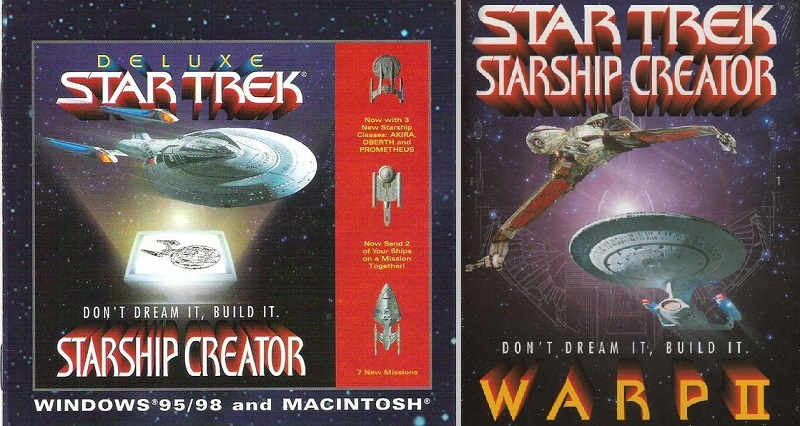
This was the golden age of Star Trek for many fans, with Deep Space Nine was towards the end of its run, Voyager in season 3, and The Next Generation movies in full swing. It was also the golden age of Star Trek video games. Between 1998 and 2000 when the two Starship Creator games were published, 15 other Star Trek games were released. SSI published some of these, along with a number of other Star Trek related software.
These licensed software toys were popular in the dawn of CD-ROM, like Star Wars: Behind the Magic (1998) or another SSI published title Daria’s Sick, Sad Life Planner (1999). The developers, Imergy, made a number of interactive CD-ROM products such as Star Trek: The Next Generation - Interactive Technical Manual (1995) and Star Trek: Captain's Chair (1997), a virtual tour of Star Trek ship’s bridges. Starship Creator (1998) and its sequel Warp II (2000) land somewhere between a game and toy.

At no point does the marketing or box describe Starship Creator as a game, but it was still received as such, and poorly so. Reviewers and players alike expected more than an interactive trekkie experience.
An add-on pack and ‘Deluxe’ edition were released a year later and Starship Creator: Warp II was released a year after that. Warp II excitingly promised downloads on the SSI website, still a novelty for the year 2000. Unfortunately I can’t find any evidence of it existing, and their website from the Wayback Machine in 2001 turns up only a “Coming Soon!!!” page. Shame on you, SSI.
The Game Loop
As advertised, you are tasked with creating starships to complete a variety of missions. The first thing you’ll notice are the familiar beeps and boops of the computer from the tv show, and its voice provided by Judi Durand who stood-in for Majel Barret in this role for many Star Trek games. The UI appropriately uses the LCARS design as seen in the tv show. I expect nothing less from Michael and Denise Okuda who worked on the game, Gods of Star Trek who created much of Star Trek’s technical lore.

There are seven famous ship types to choose from with three more in the add-on pack. You can choose different parts from three categories, with three or four options each. Choices are only cosmetic and most are very similar; slightly longer bits, slightly shorter bits, bits with bits cut out. That means of the roughly 270 possible unique ships, most of them look indistinguishable from other ships of their type. It’s very low effort.
You are then rewarded by a 3D wireframe model of the ship and then a textured version of it, which you can spin round. It’s just window dressing, but it’s rad, especially for 1998.
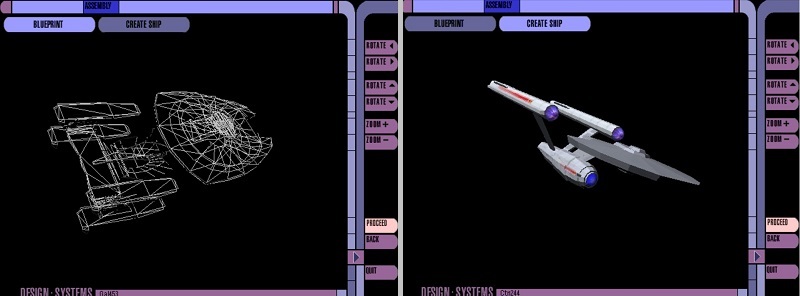
After that you must kit out all the subsystems of your empty starship, and it’s this part that trekkies will love. There is a lot of detail here from the warp core right down to the crew quarters and it’s all illustrated by the Master Systems Display, a famous type of ship schematic that is featured in the tv shows and films. As you add or change the extensive amount of systems, the diagram fills up, and you start to feel like you have your own unique starship. You can also export the diagram to PDF, just like Captain Kirk would have done!
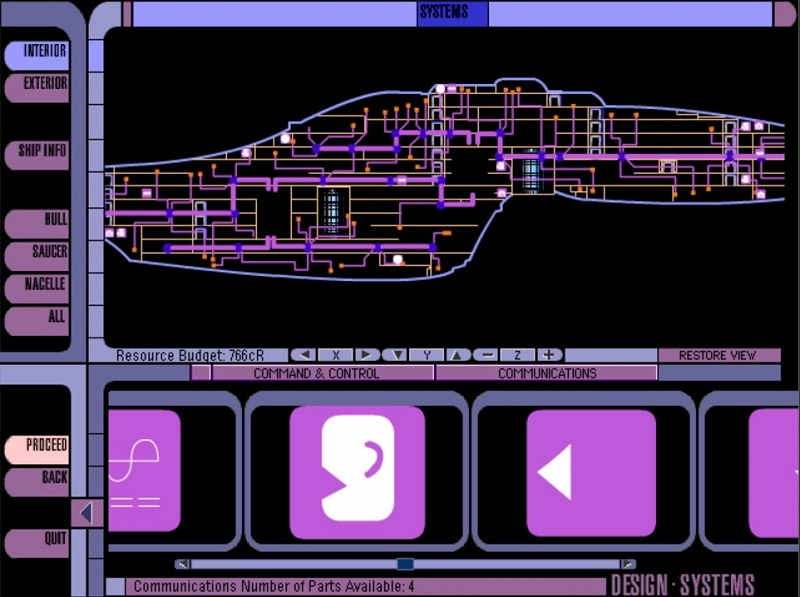
Next, choose your crew from a roster of your favourite characters. How will nervous wreck Reginald Barclay perform as your ship’s counsellor? Will you finally grant Harry Kim a promotion? This is fantasy football for Star Trek, and would be a fan’s dream if you could mix crews from different eras. In Warp II you can send the original and Next Generation Enterprises their crews on a mission together, yet you can't mix the crews on the same ship. A real shame.
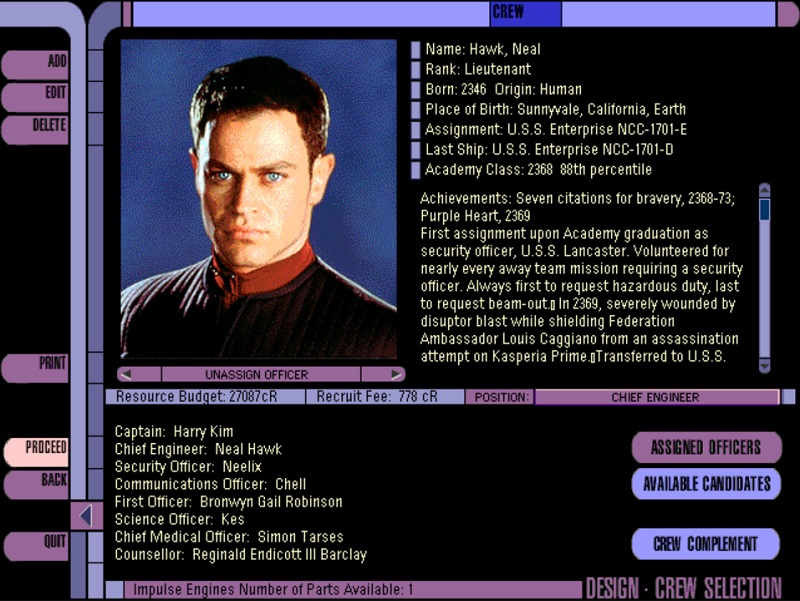
Your ship follows the mission script as you watch it play out and read messages and dialogue in the ship’s log. You don’t have any control over the mission, they either have the right systems or they don’t, and you will succeed or fail accordingly. Failure usually just means repeating the mission with a more appropriate ship.
The missions increase in difficulty and some are actually pretty good, like mini episodes played out in Tweets. Two of them were written by Star Trek novelist Peter David and many are based on episodes, mostly from DS9 and Voyager.
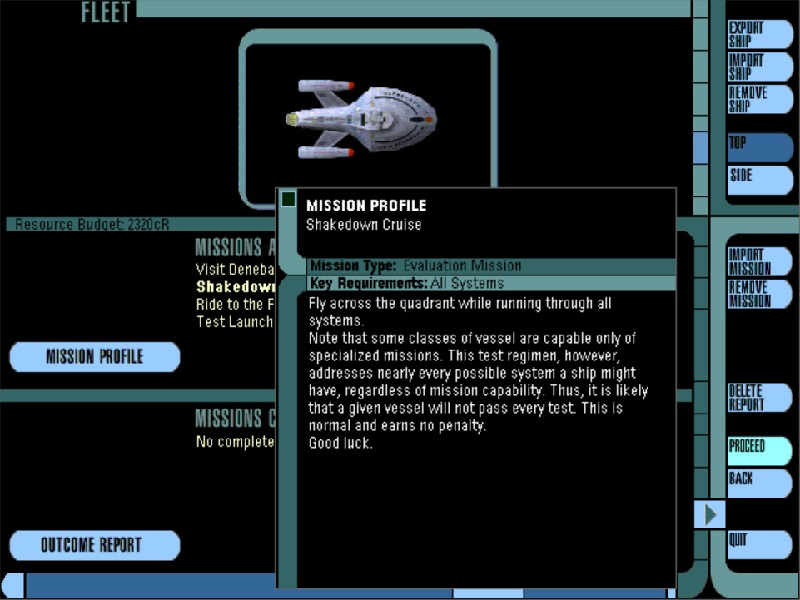
There are around 30 missions, completing them will earn you credits which you spend on better ships, systems and crew. And that’s it really.
So why are these simple games so universally reviled?
Boring Space Adventures
The main thing you will read about Starship Creator is that it’s boring. That’s not exactly accurate, the content is very enjoyable for trekkies. What they mean is that the missions are extremely, mind-numbingly, painfully slow. Later missions may take more than half an hour, even at ‘accelerated’ speed.
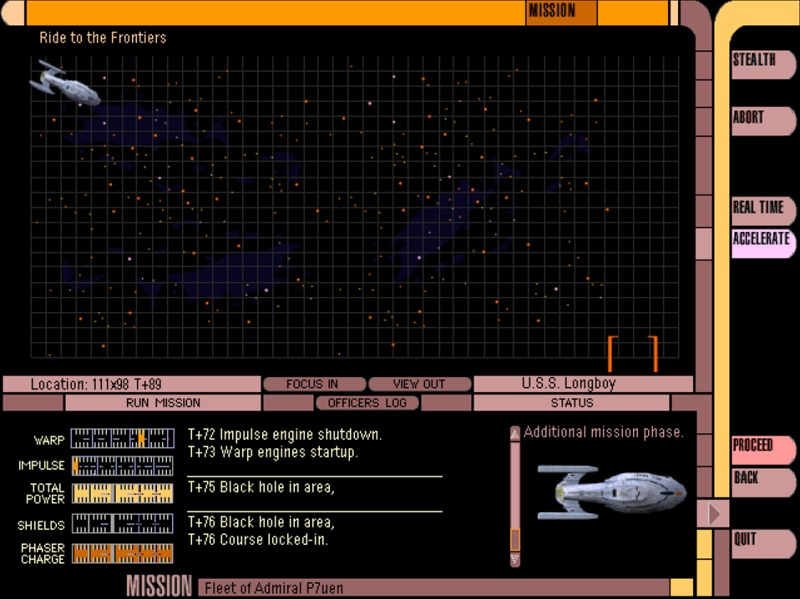
As you can tell from this website, I love boring things, and I love games you can leave running in the background while you work or watch tv. But 90% of every mission is watching a ship barely moving across the map. When a mission is completed your ship will crawl back home across the map for 10 full minutes. If you end the mission prematurely, you forfeit the reward.
Earning credits is extremely slow as well. You need around 50k credits for a new ship, and Beginner missions may net you 2 or 3k. If you’ve hit a wall with your current ship you can’t sell it, so if you want to upgrade you either grind hours of missions or painstakingly sell everything inside an existing ship to claw back some credits.
Bad for non-trekkies are the in-game descriptions, which are all in treknobabble. If you haven’t watched enough Star Trek to know how the structural integrity field may impact your maximum warp speed, you’ll have a rougher start. It doesn’t really matter because there’s not much strategy, you simply buy the best you can afford. The same goes for the crew, if you don’t know what type of crewmember Teri Hatcher played in The Next Generation, you probably won’t place her in an effective position.
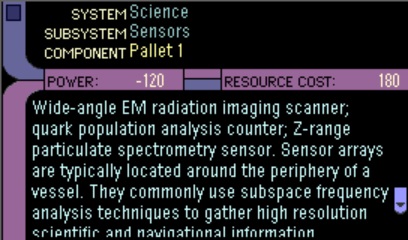
There’s no interactivity and limited feedback. If you can’t complete the mission, go home, install the correct part and run it again. There’s no rerouting power from phasers to shields or anything to help your captain like you can in Star Trek: Bridge Commander (2002) or Star Wars: X-Wing (1998), or the tv show. You might make an occasional decision such as whether to go to location X or Y, but those are rare and have no real impact.
In another weird decision, hiding the best ship parts behind the Advanced difficulty ironically meant I stayed in Beginner difficulty grinding missions for even longer because my ships were still so rubbish. The difficulty levels serve no purpose and may as well be scrapped.
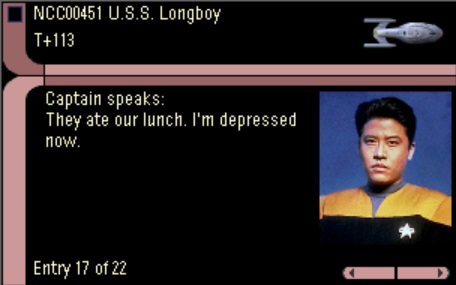
Warp II is almost identical to the first game. There’s an iconic Klingon Bird of Prey as a new ship option, but there are no unique Klingon missions so it’s not much of a change. There are a couple more crew members but it’s certainly not worthy of a full sequel. The only reason this sequel is notable is for the mission editor.
The Mission Editor
Trying the editor was eye-opening, I’ll save the examples for Part 2, in which I attempt to turn the game into an immersive sim (only slightly joking), but there is a lot of potential there.
The editor is actually very intuitive and stable, more so than the game itself. You drag and drop icons from the interface into a timeline, representing events that will happen in the mission. Add combat, scanning, crewmembers talking and checks on what systems are present on your ship, and then generate a mission script. You can create or edit scripts directly if you fancy learning that instead.
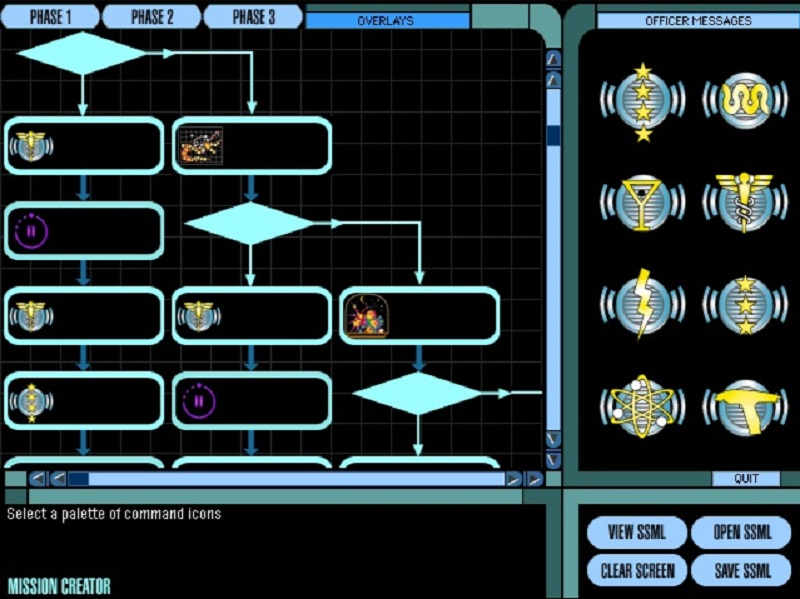
It’s fan-fiction made interactive. Indeed I did feel like I was writing fanfic while I was creating the mission, which was briefly terrifying. The editor’s events are generic and rely on the creator to give them meaning; is that ‘timer’ event a bomb about to go off, a warp core going to breach, or an alien who needs to be saved? It’s up to you. Missions can get quite complex out of this simple system, with a bit of imagination.
Lots of games such as Quake (1996) and Half-Life (1998) had good modding scenes and a lot of games included level editors in the 90s. Perhaps if it was included in the first game it would have gained more of a following, and it needed one.
The Game Community
There is not a burgeoning community for this game. I managed to find two defunct websites, both on broken, archived versions of Geocities (RIP), which provided some mods for download, and they still worked! Trekkers Anonymous and Pelios station both had ships available for download, but any of these can be created in-game. The fan-made missions are of more interest, the most recent of which was from 2003.
The greatest of all the downloads on offer though, were the crew portraits. Warp II allows the creation of custom crew members, however it crashed whenever I tried. Luckily Trekkers Anonymous had some glorious portraits including Captain Dana Scully from the X-Files and Admiral Paul Hogan, a.k.a. Crocodile Dundee.
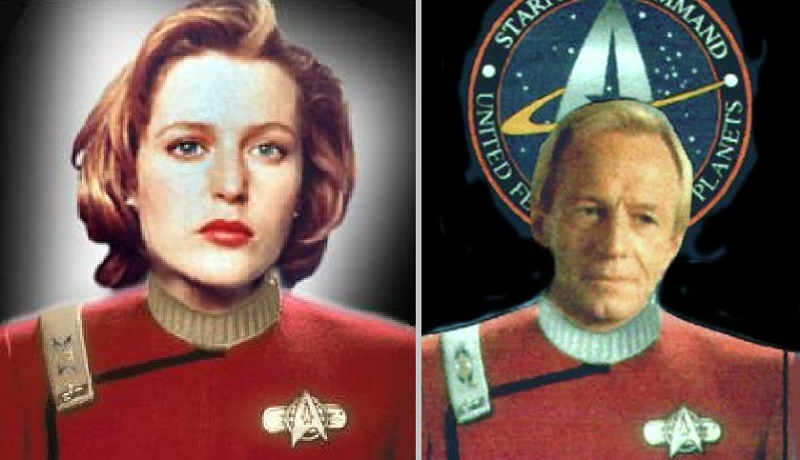
Dominion Wars
There is one additional way to put your ship through its paces. Ships can be exported from Warp II and imported to another SSI game, Star Trek: Dominion Wars (2001). In fact a copy of Warp II was included with North American versions of Dominion Wars. It’s a bit fiddly to get working but lo and behold, for a few specific ship types you can import them to a multiplayer skirmish game and use your creations! Quite exciting, migrating items between games is still something that is rare in modern games aside from the Pokemon series. The ships do look different to the base game ships, and their stats are better as well, so it can make a difference in battle.
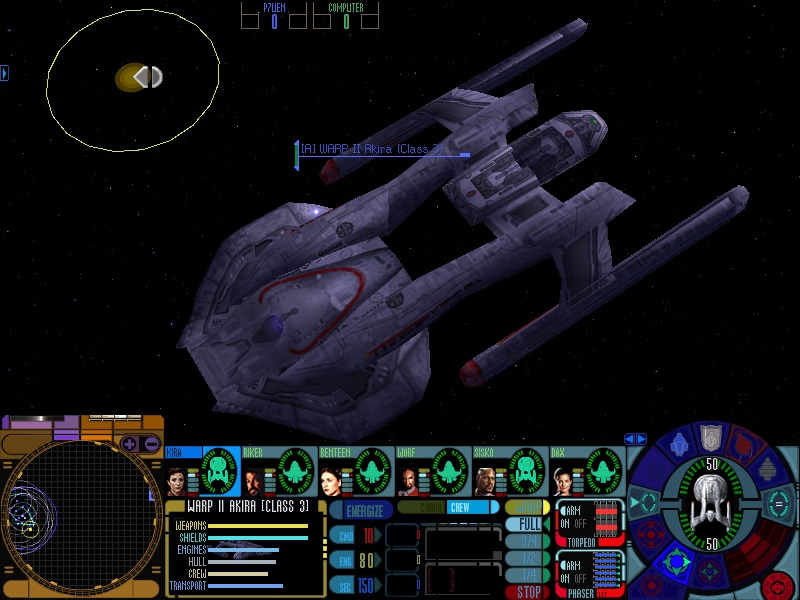
Related Games
Ok I’ll say it: Kerbal Space Program (2015) is just a Starship Creator clone. Just kidding, but it does share the same build a ship, send it on a mission template, which shows what can be achieved if the idea is done right.
In reality it’s closer to Gratuitous Fleet Battles (2009) which was a similar case of building and watching the battles play out. It was focused on rock/paper/scissors combat, and I didn't enjoy it at all. Starship Corporation (2018) looks like an option if you want a modern ship builder without the Trek license although a lot more hardcore. It has a living galaxy map layer, but the ship construction is a much smaller scale.
I haven’t played Star Trek Online (2010), but I have seen the ship builder which visually, is amazing. It has a fantastic amount of ships, parts, colours and other customisations, it’s a trekkie’s dream come true. However there is no deck planner or MSD blueprint that I could see. The ship systems are represented by dragging icons into inventory slots. Very MMO.

Fixing The Problems
First of all, more effort in the number and variety of ship parts would have been easy to do. Even just the ability to mod new 2D ships and parts would have extended the life of the game. It would have been good if the exterior parts have an effect on ship performance too.
The fantasy crew experience would be much better if crewmembers gained experience and improved their stats. There is no fun in choosing a hilariously mismatched team or training up a rookie crew, because they will simply fail and you will need to choose another.
But the biggest problems all stem from the mission design. Reduce the boring idle time by making the ship speed faster, or reducing the travel distance. The missions should provide better feedback to the player, and could provide them with gameplay decisions to engage the player. It would also be easy to tie missions together as a campaign or throughline of story instead of disjointed missions. This would also give more of a feeling of permanence to the galaxy map.
So if the main problems are with the missions, and we can create missions…
Let's see if we can fix Starship Creator.
Part 2: Righting the Ship
All game posts:
© P7uen 2023 | Base style css by EGGRAMEN 2020